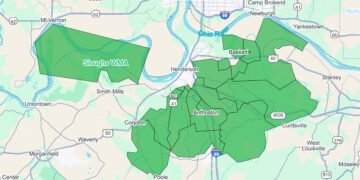Superintendent has applied for a $1.125 million grant to start getting it fixed
The bulk of a Wednesday evening Henderson County Water District meeting was spent talking about either much-needed repairs to an aging system or the loss of money that comes each month from that system.
Board members—and Superintendent Mark Julian—say it’s going to take a strategic spending of money to stop up the leaky system enough to get ahead of the system-wide problems.
Julian said leaks in the system cause the district to buy almost double the number of gallons that it ends up selling to its customers. In July, HCWD bought more than 59 million gallons of water, but customers used only 30.6 million gallons.
The county water district doesn’t do any water filtration and cleaning. That’s done by the Henderson Water Utility, which then sells the clean water to the HCWD. The water district’s job is to deliver the water to its county customers.
But that delivery has grown costly in recent years. For example, at the end of July, the water district was $182,000-plus in the red, and in July—a month in which the district took on an almost 30-million gallon water loss—HCWD lost $39,651, according to documents presented at the meeting.
“We are buying double the amount of water we are able to bill for,” Julian said.
Obviously, Julian said, that can’t continue. No organization can survive when its expenditures are consistently more than its revenue, he said.
It’s not a new problem. In one document, Julian said the HCWD system has been suffering significant water loss since 2018. Julian, meanwhile, has been superintendent for about a year.
To get out of the financial hole it’s in and to make much-needed repairs to its aging infrastructure, the HCWD is applying for a million dollar-plus grant from Kentucky WWATERS, a program created by the 2024 General Assembly and administered by the Kentucky Infrastructure Authority.
“The primary cause of water loss in the Henderson County Water District is outdated equipment,” according to a corrective action plan that Julian put together for submittal to the KIA. “This includes meters that report inaccurate figures, leaking valves, and an obsolete SCADA (a computerized monitoring and analysis) system. As the system has aged, the failure to upgrade this equipment has resulted in significant water loss and has demanded considerable time and resources from operators.”
Julian said HCWD employees regularly check for leaks in the system. On Aug. 20, district employees found two, on Aug. 26, they found five more, he said at Wednesday’s meeting. He estimated that the system has between 12 and 20 sizeable leaks.
Julian said that local municipalities, such as the HWU, have the legal ability to set their own rates, so if repairs are needed, they can up their monthly prices in a manner that offsets the costs of repairs.
The county water district can’t do that. That’s a function of the state’s Public Service Commission, which oversees the operations of all water districts.
To get a rate increase, water districts submit data to the PSC, which then analyzes it and determines the fair price for a particular district. This past year, the PSC allowed for a 7.08% increase, which Julian said is a fair rate if the system was working properly.
“I think our rates are very sufficient if we didn’t have the high water loss,” Julian said.
The PSC also granted the HCWD a $1.87 per meter per month upcharge that totals more than $11,000, a monthly amount stipulated to be used for fixing the system.
But it’s not enough.
He said he submitted the grant application to KIA after the HCWD board approved his request Wednesday night. In it, he’s asking for $1.125 million, which will be enough to get started on fixing the system, he said. To fix the entire system he estimates will cost $2.5 million.
With funding, Julian said the project would be divided into two main phases. First, leak detection equipment would need to be installed. Second, after learning the areas of most necessary repairs, HCWD will hire a contractor to make the repairs.
One casualty of the leaky system is Pleasant Valley Road resident Doug Laramie, who told the HCWD board a leak at his house in June, July and August caused at its peak a loss of 11,000 gallons per day. By the time he was able to get the water shut off, 441,000 gallons of water had leaked.
The leak went undetected because of a set of circumstances that kept the leaking water hidden. Most homeowners would notice a leak by puddles in a yard or other viewable water, but at Laramie’s house, the water fell from the leak down the side of his foundation and into a French drain system that took the water from his house on a hill to a wooded area below.
Reached after the meeting, Laramie said he was “flabbergasted” that the water district doesn’t have better protocols in place to detect and then notify residents of leaks.
Laramie’s total bill is still unclear because it occurred over three months and August’s hasn’t been processed. But Laramie said an estimate he’s been told is $3,300. The HCWD offers some help with bill payment, as noted in the water district’s tariff, but it won’t take much off.
Julian said that if the water district had better leak detection equipment, then there’s the possibility that Laramie’s problem would have been caught sooner. Now, Laramie is on the hook for the bill, with some concessions allowed by the PSC-approved tariff that provides the rules and regulations.
Laramie said he understands he’s legally obligated to pay for the water that comes across his meter. But he was frustrated that there’s nothing in place in HCWD’s processes that mandates customers whose meters appear to be showing leaks must be notified. His frustration grows knowing friends in other areas with other water providers can check usage daily on their phones.
His best advice, he said, is for county residents to walk outside and check their meters daily.
“I’m just worried that this might happen to somebody else,” Laramie said at the meeting.
Now, with the grant submitted, Julian and the HCWD board must wait and see if it’s awarded. If it’s not, Julian said the only other options would be to submit data and information to the PSC for a future rate increase—which he doesn’t want to do—or to borrow.
The PSC mandates that water districts incur less than 15% water loss from leaking, Julian said. It won’t be an easy task without funding.
Julian said the water district he inherited is like most smaller water providers in the country–they, too, are dealing with aging infrastructure and funds hard to come by. The plan Julian has put together comes from a water district in Cannonsburg, in Boyd County, which had similar circumstances before its superintendent was able to get it fixed.
“It’s time to start taking steps to turn this around,” Julian said.
























